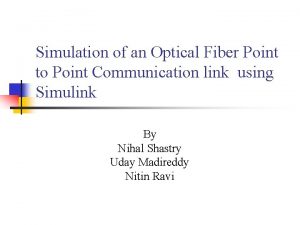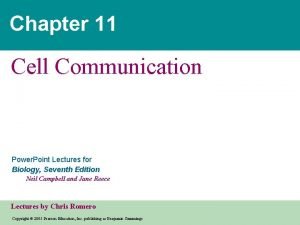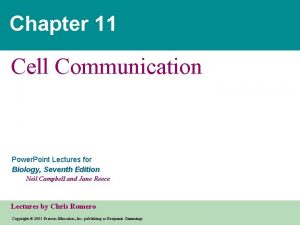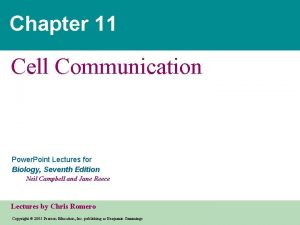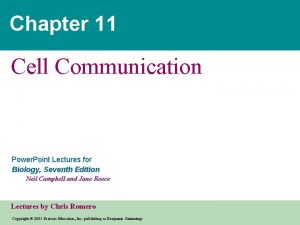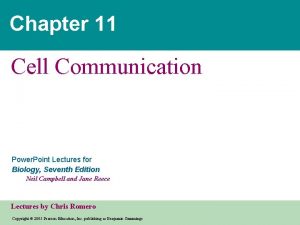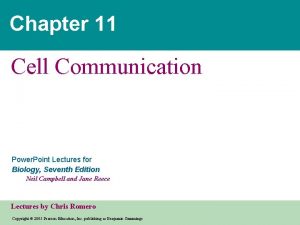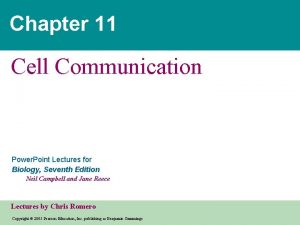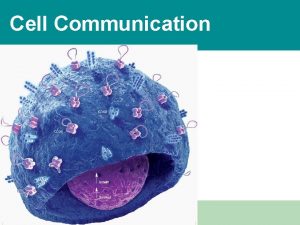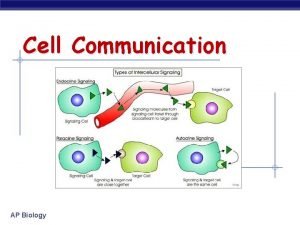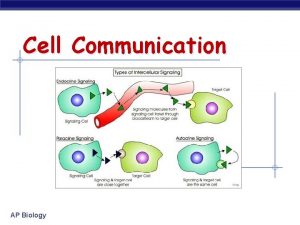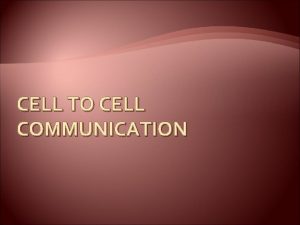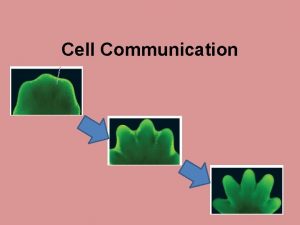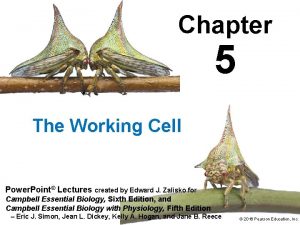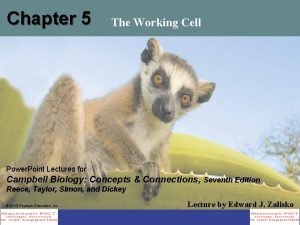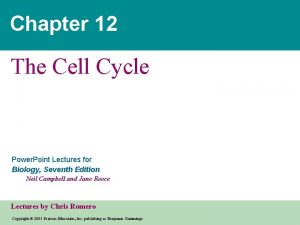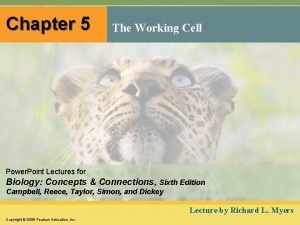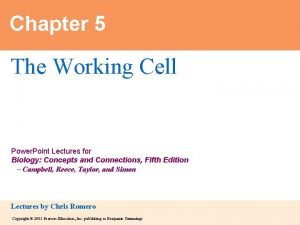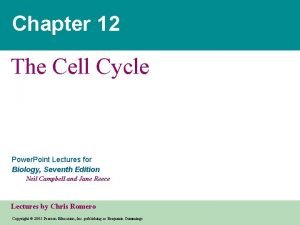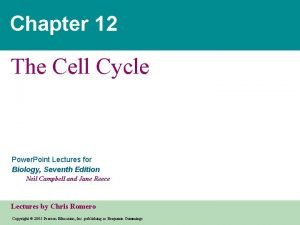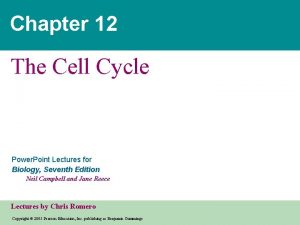Chapter 11 Cell Communication Power Point Lectures for





























- Slides: 29

Chapter 11 Cell Communication Power. Point Lectures for Biology, Seventh Edition Neil Campbell and Jane Reece Lectures by Chris Romero Copyright © 2005 Pearson Education, Inc. publishing as Benjamin Cummings

• Overview: The Cellular Internet • Cell-to-cell communication – Is absolutely essential for multicellular organisms Copyright © 2005 Pearson Education, Inc. publishing as Benjamin Cummings

• Concept 1: Reception: External signals are converted into responses within the cell Copyright © 2005 Pearson Education, Inc. publishing as Benjamin Cummings

1. Signal transduction pathways convert signals on a cell’s surface into cellular responses – Are similar in microbes and mammals. What does this mean? Copyright © 2005 Pearson Education, Inc. publishing as Benjamin Cummings

Local and Long-Distance Signaling 2. Cells in a multicellular organism communicate via chemical messengers Copyright © 2005 Pearson Education, Inc. publishing as Benjamin Cummings

3. Gap junctions in animal cells and plasmodesmata in plant cells directly connect the cytoplasm of adjacent cells Plasma membranes Gap junctions between animal cells Plasmodesmata between plant cells Figure 11. 3 (a) Cell junctions. Both animals and plants have cell junctions that allow molecules to pass readily between adjacent cells without crossing plasma membranes. Copyright © 2005 Pearson Education, Inc. publishing as Benjamin Cummings

Type 1: Autocrine Cell Signaling • Cells communicate with themselves Copyright © 2005 Pearson Education, Inc. publishing as Benjamin Cummings

Type 2: Juxtacrine Cell Signaling – Signaling depends on direct contact Figure 11. 3 (b) Cell-cell recognition. Two cells in an animal may communicate by interaction between molecules protruding from their surfaces. Copyright © 2005 Pearson Education, Inc. publishing as Benjamin Cummings

Type 3: Paracrine cell signaling – local cells communicate with each other Local signaling Target cell Electrical signal along nerve cell triggers release of neurotransmitter Neurotransmitter diffuses across synapse Secretory vesicle Local regulator diffuses through extracellular fluid (a) Paracrine signaling. A secreting cell acts on nearby target cells by discharging molecules of a local regulator (a growth factor, for example) into the extracellular fluid. Copyright © 2005 Pearson Education, Inc. publishing as Benjamin Cummings Target cell is stimulated (b) Synaptic signaling. A nerve cell releases neurotransmitter molecules into a synapse, stimulating the target cell.

Type 4: Endocrine Cell Signaling • long-distance signaling, hormones are used Long-distance signaling Blood vessel Endocrine cell Hormone travels in bloodstream to target cells Target cell (c) Hormonal signaling. Specialized endocrine cells secrete hormones into body fluids, often the blood. Hormones may reach virtually all body cells. Copyright © 2005 Pearson Education, Inc. publishing as Benjamin Cummings

• 3 Step Process – Reception – Transduction – Response Copyright © 2005 Pearson Education, Inc. publishing as Benjamin Cummings

• Overview of cell signaling EXTRACELLULAR FLUID 1 Reception CYTOPLASM Plasma membrane 2 Transduction 3 Response Receptor Activation of cellular response Relay molecules in a signal transduction pathway Signal molecule Figure 11. 5 Copyright © 2005 Pearson Education, Inc. publishing as Benjamin Cummings

4. The binding between ligand receptor is highly specific 5. When ligand bonds to a receptor, receptor changes shape, resulting in a response from the cell Copyright © 2005 Pearson Education, Inc. publishing as Benjamin Cummings

• Signal molecules that are small or hydrophobic – And can readily cross the plasma membrane use these receptors Copyright © 2005 Pearson Education, Inc. publishing as Benjamin Cummings

Receptors in the Plasma Membrane • There are three main types of membrane receptors – G-protein-linked – Tyrosine kinases – Ligand Gated Ion channel Copyright © 2005 Pearson Education, Inc. publishing as Benjamin Cummings

• Ion channel receptors Signal molecule (ligand) Gate closed Ions Ligand-gated ion channel receptor Plasma Membrane Gate open Cellular response Gate close Figure 11. 7 Copyright © 2005 Pearson Education, Inc. publishing as Benjamin Cummings

• Concept 2: Transduction: Cascades of molecular interactions relay signals from receptors to target molecules in the cell • Multistep pathways – Can amplify a signal – Provide more opportunities for coordination and regulation Copyright © 2005 Pearson Education, Inc. publishing as Benjamin Cummings

Signal Transduction Pathways 6. Can be multiple steps in a pathway a. At each step in a pathway the signal is transduced into a different form Copyright © 2005 Pearson Education, Inc. publishing as Benjamin Cummings

b. This is called a cascade Signal molecule Receptor Activated relay molecule Inactive protein kinase 1 1 A relay molecule activates protein kinase 1. Active protein kinase 1 de Copyright © 2005 Pearson Education, Inc. publishing as Benjamin Cummings Pi a sc Figure 11. 8 ATP ca Inactive protein kinase 3 on PP Active protein kinase 2 3 then catalyzes the phosphorylation (and activation) of protein kinase 3. P Active protein kinase 2 ADP i lat ATP Pi Enzymes called protein 5 phosphatases (PP) catalyze the removal of the phosphate groups from the proteins, making them inactive and available for reuse. ory ph Inactive protein kinase 2 os Ph Active protein kinase 1 2 transfers a phosphate from ATP to an inactive molecule of protein kinase 2, thus activating this second kinase. ADP Active protein kinase 3 PP Inactive protein P Finally, active protein 4 kinase 3 phosphorylates a protein (pink) that brings about the cell’s response to the signal. ATP ADP P i PP P Active protein Cellular response

b. A cascade is basically a large chain reaction Signal molecule Receptor Activated relay molecule Inactive protein kinase 1 1 A relay molecule activates protein kinase 1. Active protein kinase 1 de Copyright © 2005 Pearson Education, Inc. publishing as Benjamin Cummings Pi a sc Figure 11. 8 ATP ca Inactive protein kinase 3 on PP Active protein kinase 2 3 then catalyzes the phosphorylation (and activation) of protein kinase 3. P Active protein kinase 2 ADP i lat ATP Pi Enzymes called protein 5 phosphatases (PP) catalyze the removal of the phosphate groups from the proteins, making them inactive and available for reuse. ory ph Inactive protein kinase 2 os Ph Active protein kinase 1 2 transfers a phosphate from ATP to an inactive molecule of protein kinase 2, thus activating this second kinase. ADP Active protein kinase 3 PP Inactive protein P Finally, active protein 4 kinase 3 phosphorylates a protein (pink) that brings about the cell’s response to the signal. ATP ADP P i PP P Active protein Cellular response

Fine-Tuning of the Response 7. Cascades with multiple steps can amplify the signal Copyright © 2005 Pearson Education, Inc. publishing as Benjamin Cummings

Small Molecules and Ions as Second Messengers 8. Second messengers are small molecules or ions that become messenger after cell is activated by first messenger Copyright © 2005 Pearson Education, Inc. publishing as Benjamin Cummings

Cyclic AMP Copyright © 2005 Pearson Education, Inc. publishing as Benjamin Cummings

• Many G-proteins – Trigger the formation of c. AMP, which then acts as a second messenger in cellular pathways First messenger (signal molecule such as epinephrine) G protein G-protein-linked receptor Adenylyl cyclase GTP ATP c. AMP Protein kinase A Figure 11. 10 Copyright © 2005 Pearson Education, Inc. publishing as Benjamin Cummings Cellular responses

9. Some pathways regulate genes turning them on or off Growth factor Reception Receptor Phosphorylation cascade Transduction CYTOPLASM Inactive transcription Active transcription factor P Response DNA Gene Figure 11. 14 NUCLEUS Copyright © 2005 Pearson Education, Inc. publishing as Benjamin Cummings m. RNA

• Concept 3: Response: Cell signaling leads to regulation of cytoplasmic activities or transcription Copyright © 2005 Pearson Education, Inc. publishing as Benjamin Cummings

Protein Phosphorylation and Dephosphorylation 10. Many signal pathways include phosphorylation cascades Copyright © 2005 Pearson Education, Inc. publishing as Benjamin Cummings

11. In this process a series of protein kinases add a phosphate to the next one in line, activating it Copyright © 2005 Pearson Education, Inc. publishing as Benjamin Cummings

• A phosphorylation cascade Signal molecule Receptor Activated relay molecule Inactive protein kinase 1 1 A relay molecule activates protein kinase 1. ory ph ATP Figure 11. 8 Copyright © 2005 Pearson Education, Inc. publishing as Benjamin Cummings Pi ADP Active protein kinase 3 PP Inactive protein P Finally, active protein 4 kinase 3 phosphorylates a protein (pink) that brings about the cell’s response to the signal. ATP ADP P i PP de Enzymes called protein 5 phosphatases (PP) catalyze the removal of the phosphate groups from the proteins, making them inactive and available for reuse. ATP a sc Inactive protein kinase 3 ca PP on Pi Active protein kinase 2 3 then catalyzes the phosphorylation (and activation) of protein kinase 3. P Active protein kinase 2 ADP i lat Inactive protein kinase 2 os Ph Active protein kinase 1 2 transfers a phosphate from ATP to an inactive molecule of protein kinase 2, thus activating this second kinase. Active protein kinase 1 P Active protein Cellular response
 Molecular biology lectures
Molecular biology lectures Power system lectures
Power system lectures Oral communication 3 lectures text
Oral communication 3 lectures text Triangle of power
Triangle of power Informsu
Informsu Point point power
Point point power Optical fiber simulation
Optical fiber simulation Chapter 4 cell theory and cell study
Chapter 4 cell theory and cell study Rick trebino
Rick trebino Neonatology lectures
Neonatology lectures Data mining lectures
Data mining lectures Medicinal chemistry lectures
Medicinal chemistry lectures Orthopedic ppt lectures
Orthopedic ppt lectures Ludic space
Ludic space Activity planning software project management
Activity planning software project management Radio astronomy lectures
Radio astronomy lectures Dr sohail lectures
Dr sohail lectures Utilities and energy lectures
Utilities and energy lectures Introduction to web engineering
Introduction to web engineering Do words have power
Do words have power Frcr physics lectures
Frcr physics lectures Frequency of xrays
Frequency of xrays Cs106b lectures
Cs106b lectures Rbc formation stages
Rbc formation stages Aerodynamics lectures
Aerodynamics lectures Theory of translation lectures
Theory of translation lectures Theory and practice of translation lectures
Theory and practice of translation lectures Theory of translation lectures
Theory of translation lectures Digital logic design lectures
Digital logic design lectures Jim kurose gaia
Jim kurose gaia






